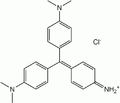Methyl violet
Template:Chembox new Methyl violet is the name given to a group of similar chemicals used as pH indicators and dyes. Methyl violets are mixtures of tetramethyl, pentamethyl and hexamethyl pararosanilins. By blending the different versions, the dyemaker can create different shades of violet in the final dye. The more methylated the compound (the more methyl groups attached), the deeper blue the final color will be:
- Tetramethyl (four methyls) is known as methyl violet 2B, and this specific chemical finds uses in chemistry and medicine.
- Pentamethyl (five methyls) is known as methyl violet 6B, and is darker (in dye form) than 2B.
- Hexamethyl (six methyls) is known as methyl violet 10B, or specifically as crystal violet. This is much darker than 2B, and often darker than 6B.
In pure form, the tetramethyl appears as lustrous blue-green crystals that melt at 137°C (279°F).
The main use of methyl violet (by sheer volume used worldwide) is to dye textiles purple and give deep violet colors in paints and printing ink.
Methyl violet 2B (simply called methyl violet) is used in chemistry as a pH indicator to test pH ranges from 0 to 1.6. At the acid end of its measuring range, it takes on a yellow color. At the alkaline end, it becomes bluish-violet. Methyl violet can be supplied as premade pH testing paper, or it can be supplied as pure crystals and dissolved in the sample being checked.
| Methyl violet 2B (pH indicator) | ||
| below pH 0.0 | above pH 1.6 | |
| 0.0 | ⇌ | 1.6 |
In medicine, Methyl Violet 10B is known as Gentian violet and is the active ingredient in Gram's stain, used to classify bacteria. Gentian violet destroys cells, and is used as a moderate-strength external disinfectant. Gentian violet is very poisonous to most animals, dogs and cats included — do not use it as a disinfectant for animals' skin.
Methyl violet has also the ability of binding DNA. Therefore, in biomedical sciences, it is used for cell viability assays. The binding to DNA can also cause disruption in DNA replication process, which can lead to mutations and cancers.
Methyl violets are soluble in water, ethanol, diethylene glycol, and dipropylene glycol. Specifically, methyl violet 6B is 2.93% soluble in water and 15.21% soluble in ethanol.
Methyl violet should not be confused with methyl blue or methylene blue, two other stains.
-
Methyl Violet 2B
-
Methyl Violet 6B
-
Methyl Violet 10B
References
- Kristallviolett – ein pH-Indikator (in German)



